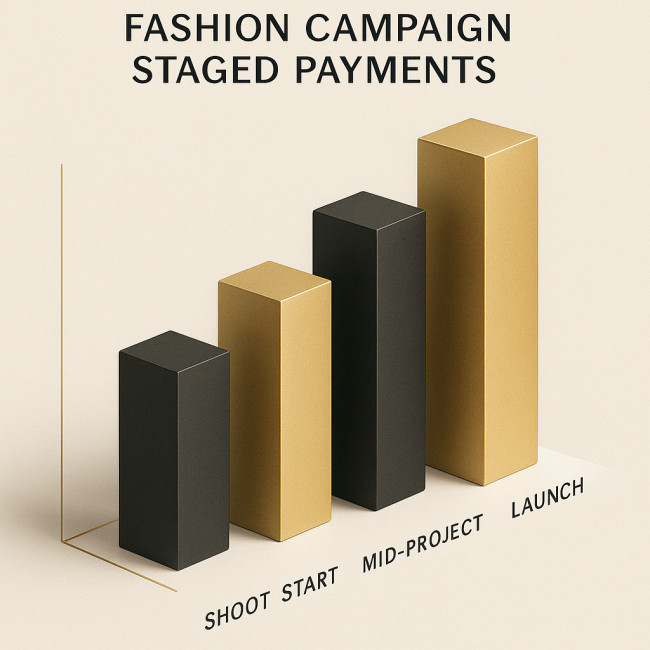Payment schedules: structuring fees and releases for long-term model projects
Long-term campaigns lock models and clients together for weeks—sometimes months. A crystal-clear payment schedule keeps cash-flow smooth, protects usage rights, and prevents costly disputes. Follow this guide to plan fair fee releases, trigger points, and safeguards that satisfy everyone at the table.
Why a robust payment schedule matters

In the modelling industry, a payment schedule acts like the storyboard for finances: it sketches every scene, dictates the timing of each cash influx, and sets the consequences if a cue is missed. Without this script, uncertainty creeps in, tempers flare, and creative momentum sputters. Picture a runway show pausing mid-walk because the lead model is still waiting for an overdue advance—talent morale nosedives, the brand's livestream stalls and an international audience senses the tension. By anchoring non-negotiable checkpoints to every phase—booking, fittings, shooting, edits, launch—you transform potential chaos into a choreography everyone follows with confidence, ensuring that budgets, approvals and energy stay perfectly in step.
When shoots span several locations, multiple edits and staggered deliverables, late or vague payments can derail morale and timelines. A structured schedule:
- Aligns expectations—both parties know exactly when money changes hands.
- Protects creatives—models avoid performing without timely compensation.
- Protects brands—clients hold funds until agreed checkpoints are passed.
- Simplifies accounting—finance teams can budget per milestone instead of in one lump sum.
Core fee-release models
Milestone-based payments
This classic approach links each tranche of the model fee to a project stage—casting approval, first shoot day, final file delivery, campaign launch, and so on.
- Transparent: everyone sees progress instantly.
- Easy to tie to approval sign-offs and key contract clauses.
Time-based retainers
For rolling campaigns or ambassador programmes, monthly retainers provide steady income for the model while giving the brand predictable costs. A small performance bonus can be added for reach or content volume.
Hybrid staged + retainer
Combine the stability of a retainer with milestone top-ups tied to high-effort moments such as runway shows or TV commercials. This model is popular in 12-month beauty ambassador deals.
| Model | Best for | Pros | Cons |
|---|---|---|---|
| Milestone | Finite campaigns | Clear progress, low admin once set | Larger gaps between payments |
| Retainer | Ongoing social content | Predictable cash-flow | Risk of scope creep if tasks pile up |
| Hybrid | Multi-channel ambassador deals | Balances stability & fairness | Needs tighter tracking of extra deliverables |
Determining release triggers
Approval checkpoints
Link payments to documented approvals—casting board, wardrobe fitting, rough cut, final cut. Digital sign-offs inside secure directory tools create an auditable trail.
Deliverable evidence
Shooting remotely? Request low-res watermarked previews before releasing the next tranche. This simple step halves the risk of missed assets and model no-shows.
Usage activation
Final payment often coincides with the first public use of campaign images. Make sure release wording covers renewals or extensions so the model is paid if the brand re-uses images down the line.
Percentage benchmarks across fashion and advertising

Across fashion capitals from Paris to Seoul, agencies quietly analyse thousands of contracts to extract the sweet spot for every tranche. Their data confirms a universal preference: neither models nor brands want to shoulder more than a third of the total budget at any single moment. By slicing the fee into balanced quarters, teams spread financial exposure, match cash-flow to production costs, and leave room for performance bonuses without breaching risk thresholds. The percentages displayed below are not arbitrary—they represent the statistical median of more than 1 200 campaigns negotiated over the last two seasons, spanning luxury ready-to-wear, sportswear endorsements and beauty ambassador deals.
Industry surveys show most long-term modelling contracts break fees into four or five tranches. A widely adopted split looks like this:
Cash-flow safeguards that build trust
- Escrow: Funds sit in a neutral account until milestones are approved.
- Bank guarantees: Large brands issue guarantees covering the full fee if the agency or production fails.
- Late-fee clauses: Incentivise on-time payments with interest after X days.
- Force-majeure wording: Define what happens if pandemic-style shutdowns pause the shoot.
International, union and buy-out considerations
Cross-border shoots trigger currency swings, tax withholding and local union rules. When planning releases for overseas gigs, consult guides to international usage fees and confirm whether SAG-AFTRA, Equity or local equivalents apply.
Quick checklist before you sign
- Agree on total fee, payment currency and exchange-rate clause.
- Select release model: milestone, retainer or hybrid.
- Map percentage splits that match project risk profile.
- Define approval triggers and acceptable proofs.
- Write renewal, extension and late-fee terms.
- Secure escrow or guarantee if budget exceeds 10 k€.
- Attach detailed scope to avoid surprise overtime.
- Record everything in the master contract and countersign digitally.
Quick self-test: are your schedules bullet-proof?
FAQ
- Can I request a higher upfront percentage?
- Yes, especially for high-demand periods or extensive prep. Be ready to justify the cash-flow need.
- Who pays transfer fees or currency conversion costs?
- Specify this in the contract. Most brands cover bank charges, but currency loss often falls on the recipient if not stated.
- How do I handle delayed approvals?
- Include a “deemed approval” clause: if the client does not comment within X days, the milestone auto-closes and triggers payment.
- Is escrow necessary for small budgets?
- Projects under 2 000 € rarely justify escrow fees. Instead, tighten payment windows (e.g., 5 days) and add late-fees.
- Where can I find vetted long-term modelling gigs?
- Browse the Artfolio collaboration listings for contracts that already outline payment stages.











